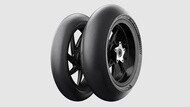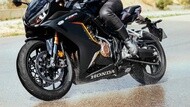
Tips and advice motorbike
You’ll have noticed motorcycle tyres have a tread pattern. But what is its job? Why does it differ from one tyre to the next? And why do certain motorbike tyres not have any at all? Allow us to explain in this article.
Striving for better performance
A tyre is designed to perform well in certain conditions and use. As we’re going to see, a tyre’s tread pattern allows us to improve certain aspects of its performance and to specialise tyres for certain uses. However, in some cases, having no tread pattern is preferred.
High-performance motorbike tyres on dry roads
Aside from the composition of the tyre, which can improve performance in certain conditions, its tread pattern also plays an extremely important role. A tyre’s grip depends on the amount of rubber that’s in contact with the ground. On a track, in dry conditions, a tyre with no tread pattern (Slick tyre) allows for maximum contact with the tarmac, giving the tyre maximum grip.
But motorbike tyres with no tread pattern are limited to "NHS" (Not for Highway Service) ranges. These are tyres designed for competitions which cannot (and must not) be used off the track. This is because a slick tyre offers optimal performances in dry conditions, but not when it's wet.

Slick motorbike tyres are the ones that perform best on dry surfaces

The MICHELIN Power Performance Slick tyre has no tread pattern
High-performance motorbike tyres on wet roads
On the roads, riders have no other choice than to use road legal tyres, making it the responsibility of manufacturers to create motorbike tyres that meet the requirements. To be considered road legal, a tyre must be suited to riding on roads in all conditions, whether wet or dry.
This is why motorbike tyres need to have a tread pattern. In order to perform well on wet surfaces, a tyre needs to have grooves that allow it to store and displace water while moving.

The MICHELIN Power 6 tyre features a high-performance tread pattern for wet surfaces
High-performance motorbike tyres for all surfaces
Off-road tyres also need a tread pattern, but for an entirely different reason: they need to provide expected performance on different types of surfaces, including mud, soil, stones, sand etc. Since traction and grip are essential for off-roading, a tread block pattern is necessary.

The MICHELIN StarCross 6 tyre features a tread block pattern for effective traction
It’s about compromise
For tyres, it's always a question of compromise. And this doesn’t just refer to a tyre’s construction (its structure) and the quality of the rubber, but also the tread pattern. As we've seen, a tread pattern helps improve necessary performance aspects in a given context, but comes at a cost.
If a tyre performs well on wet surfaces thanks to its tread pattern, its dry performance will be worse than what it would be if it were totally smooth. We therefore have to find the best compromise between these two different designs to allow riders to use motorbike tyres that are road legal, but still perform well on both types of surfaces.
So, when designing a tread pattern, we have to find just the right balance between the advantages and drawbacks. For example, it's important that a tyre wears in a regular way, equally on both wheels.
Added grip in the wet
MICHELIN specialises in 2D and 3D sipes, one of their own inventions. Sipes are deep cuts in a tread pattern which substantially improve a tyre’s performance.
They have significantly improved safety on wet roads, on top of the already improved grip on this type of surface offered by silicon-based compounds. Essentially, the role of the sipes is to disperse the thin layer of water on the ground in order to keep the wheel dry and improve grip in wet conditions.
Reducing noise
One of the drawbacks of a tread pattern is that it can produce a lot more sound than a smooth tyre tread would. At Michelin, we don’t design tyres solely for the purpose of having the best performance in given conditions. We also think about comfort for the rider.
What does this mean?
If the tread blocks that make up the tread pattern are all the same shape and size, the wheels can begin to vibrate, causing noise. Inevitably, this risks spoiling your riding experience.
That's why we’ve designed motorbike tyres with a ‘variable pitch’ system, which means varying the size of the tread blocks and the spacing between them.

Variable pitches help reduce noise when riding
Aesthetics in mind
While tread pattern is critical for improving performance in certain areas, it's also important for aesthetic reasons.
Online or in person, your first contact with our tyres is visual. It’s the appearance of the tread pattern that shapes your first impression. Sometimes, you’ll recognise a manufacturer's signature style before you see the brand.
It’s well known that, as well as riding performance, we focus on aesthetics for our motorbike tyres. We give our motorbike tyres a certain elegance and character that, we hope, will help reassure you of the performance they can offer you.
Conclusion
As you've seen, designing a tyre requires compromise, but that’s not something we leave up to chance. Our motorbike tyres are meticulously designed according to their use. And when it comes to tread patterns, through research and testing we find the best possible compromise between drawbacks and advantages to optimise expected performance, while keeping comfort and aesthetics in mind. And all of this for the benefit of you, the rider.
Find the right tyre
Enter your Reg, vehicle or tyre size
We're searching for your tire...
Wait few seconds we're processing your photo

